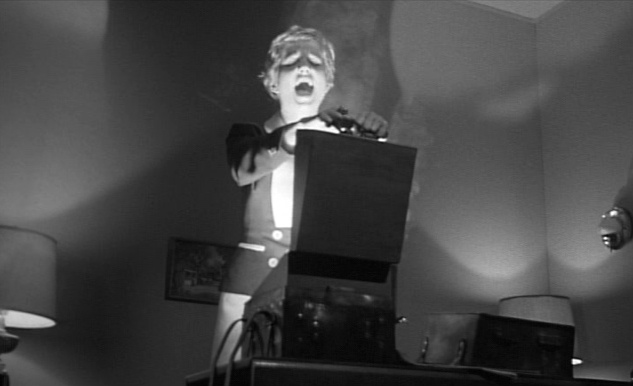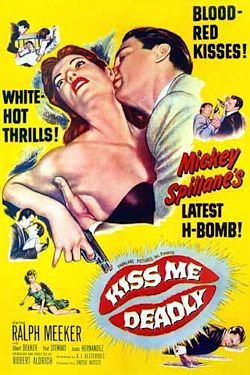There’s a point near the middle of 1955’s Kiss Me Deadly where the film changes from one of the grimmest, most brutal films noir you’ll ever see into a science fiction film. It doesn’t involve aliens or spaceships, but it does involve eerily prescient “futuristic” technology. (Full disclosure: this film was a major inspiration for my own novel Burn Me Deadly, as the similar titles acknowledge.)
Mickey Spillane’s original novel involved merely a missing cache of heroin. His thuggish protagonist Mike Hammer battered his way through good guys and bad in a quest for revenge against the people who killed a woman under his protection and left him for dead as well, all in pursuit of the drugs. From this rather pedestrian source, director Robert Aldrich and his screenwriter A.I. Bezzerides fashioned a film that deconstructs Spillane’s hero, showing him as the Neanderthal brute that he is by contrasting him with both the world around him and a hint of the world to come. (WARNING: spoilers to follow!)
Instead of heroin, the plot turns around a mysterious suitcase-sized box that, when opened, emits a bright burning light (Quentin Tarantino stole this for Pulp Fiction). The box turns out to be a nuclear bomb, although this is never explicitly stated. In the atomic-paranoid fifties, it didn’t have to be. Instead, Hammer’s cop friend Murphy delivers this classic bit of indirect dialogue:
“Now listen, Mike. Listen carefully. I’m going to pronounce a few words. They’re harmless words. Just a bunch of letters scrambled together. But their meaning is very important. Try to understand what they mean. Manhattan Project, Los Alamos, Trinity.”
Later, chief villain Dr. Soberlin tells his accomplice Lily, “The head of Medusa. That’s what’s in the box, and who looks on her will be changed not into stone but into brimstone and ashes.”
These references would have been clear as neon to the audiences of the time.

Hammer, like the dope that he is in the film, indirectly causes the box to be opened in an isolated beach house, setting off a nuclear blast and, by implication, armageddon. He and his sleazy but loyal secretary Velda watch in dumbstruck awe as the blast grows, looking far weirder and stranger than an actual atomic blast. The film doesn’t show them being killed, but the implication is clear (when originally released, the ending was re-edited by the studio to imply that Mike and Velda escape, but thankfully that ending has been removed, reduced to a mere extra on the DVD and Blu-Ray).
So is Kiss Me Deadly (the film) true SF? If we go by one of Isaac Asimov’s definitions, then yes: “That branch of literature which is concerned with the impact of scientific advance upon human beings.” The Bomb was common knowledge at the time, but the idea that it could be miniaturized and carried in a suitcase was pure, prescient SF. So long before Blade Runner, Kiss Me Deadly showed that the gritty urban detective genre could easily meld with futurism and science fiction.
Alex Bledsoe, author of the Eddie LaCrosse novels (The Sword-Edged Blonde, Burn Me Deadly, and the forthcoming Dark Jenny), the novels of the Memphis vampires (Blood Groove and The Girls with Games of Blood) and the first Tufa novel, the forthcoming The Hum and the Shiver.










